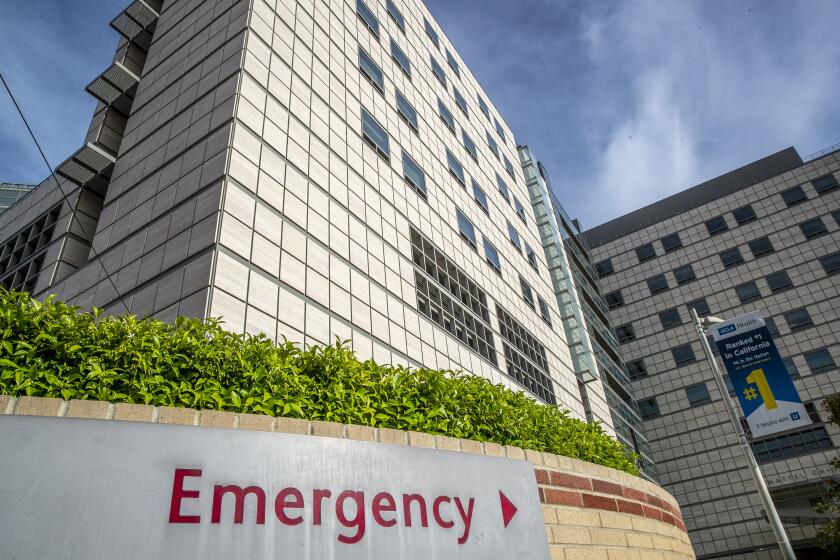Gas Station Fuels Fight in Palm Springs
- Share via
PALM SPRINGS — George Jetson could have fueled up here. Austin Powers, ‘60s hipster of the film by the same name, would have found this gas station groo-oovy baby.
But yesterday’s vision of Tomorrowland is now a faded pink gas station on the edge of town. And a move to make the Albert Frey-designed building a historical site is pumping plenty of controversy into this resort town, which now favors a downtown look of Spanish Mediterranean buildings with outdoor misting systems.
To some, the 34-year-old gas station with its soaring roof is a Palm Springs icon.
“You come out of the turn after miles of desert and there it is like an arrow pointing the way. It says, ‘Here we are: Palm Springs!’ ” said Susan Kiskis, 44. “This is not your normal gas station.”
But developer Mark Bragg wants the corner where the gas station stands to be a landscaped entryway of waterfalls and rocks to Shadowrock, a proposed $200-million golf resort. His plan will be quashed if the City Council votes to protect the building, which could happen in June.
“This is not about Albert Frey’s architecture. This is about whether six self-appointed members of a . . . historical committee are going to control what someone does with their private property. I will fight this kind of dictatorship,” he said.
*
The gas station was designed in 1963, a time of Jell-O molds, beehive hairdos and “Walt Disney’s Wonderful World of Color.” Then-mayor Frank Bogert asked Frey, a pioneer of modernism, to design a gas station that was “something spectacular.”
“He said, ‘It’s at the city’s entrance, so it should be something to make people say, ‘Now here’s an interesting town,’ ” recalled the 93-year-old Frey, a longtime Palm Springs resident.
Bogert now says he doesn’t know what he was thinking.
“Today I would have said Spanish-Mexican-European. I don’t like modern, fancy, dad-gum buildings,” said Bogert, the 72-year-old author of “Palm Springs--First One Hundred Years,” a coffee-table book featuring many pictures of a young, handsome Bogert with Hollywood starlets.
Elizabeth Kieley, granddaughter of a Palm Springs founding family and member of the historical society, remembers the reaction when the gas station was built. “All the remarks were, ‘Well, it’s certainly different,’ ” she said.
Frey, a Swiss emigre who stands on his head every morning to keep in shape, was of the school of modern architecture dedicated to the idea that everyday life could be elevated through design. He believed that buildings could be made of affordable industrial materials such as concrete, brick and metal.
His many works in Palm Springs include City Hall and his own glass-and-concrete showcase home, a favorite location for fashion photographers.
“I came to California because it was pioneering in a general way,” Frey said. “I think it had something to do with the movies. They were new and it opened people to the possibilities. California was about new things.”
But architecture that makes a good page in an art history book doesn’t make good business, said Marvin Roos, a private planning consultant.
“When you’re asking a guy to invest millions of dollars in a project, do you think he wants a project that most people like and feel comfortable with--say something Mediterranean--or something that’s going to challenge their very perception of architecture?” he asked. “That’s why Shadowrock doesn’t want the gas station.”
What Frey calls a “hyperbolic paraboloid” roof never did much to help sell gas.
Once the heyday of Chevy Impalas and finned Thunderbirds passed, a long line of gas station leases went out of business.
Chuck Labouni, owner of Julian’s Market, a neighborhood store that is always bustling with children counting change to buy lemon drops, gave the gas station a go in the late ‘80s.
“I never looked at it as a historian. I looked at it as a business that didn’t work,” he said. “This city is just weird. They want to make it a monument but it’s not like they would stop there to buy gas or a bag of Corn-nuts.
“That building was good for its time but now it’s not just too old, it’s too yucky.”
*
When Frey visited the abandoned gas station recently, even he was taken aback by its new pink color, though he had been warned beforehand.
“I like a certain kind of coral, or a dusty terra-cotta that blends with the mountains, but this pink,” he says shaking his head. “It makes you think of all sorts of things--like underwear that got washed in the wrong load.”
The pink was the idea of the last tenants who topped it off with mint-green trim, all without a permit.
“We would never have approved it,” said City Planning Manager Richard Patenaude. “That’s a color scheme more appropriate to a Mediterranean building.”
Or lawn flamingos, as some residents were quick to point out.
Frey shook his head at the pink and kicked at the dirt in the planters, where even the weeds looked pathetic and scorched. The gas station once had landscaping notable enough to win an award from Lady Bird Johnson.
Tall, thin and as angular as one of his buildings, the man who whose work was featured at New York’s Museum of Modern Art was wearing a pair of sunglasses he’s had since 1963.
He’s not a man who believes in throwing things away. And that goes for vintage gas stations, too.
“I designed the building so it was functional in every way,” Frey said. “Surely it could be used in some way now?”
More to Read
Sign up for Essential California
The most important California stories and recommendations in your inbox every morning.
You may occasionally receive promotional content from the Los Angeles Times.














